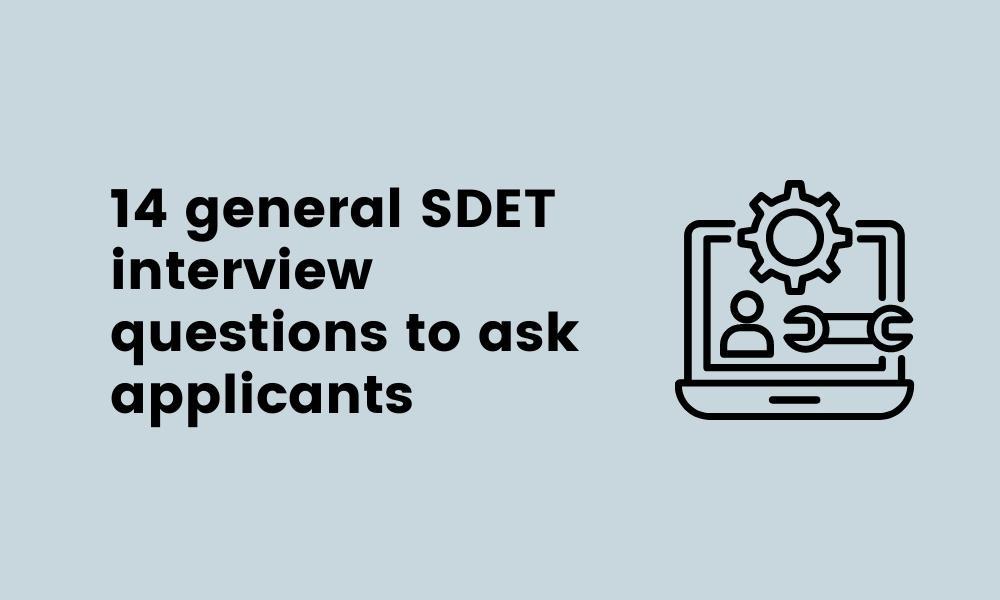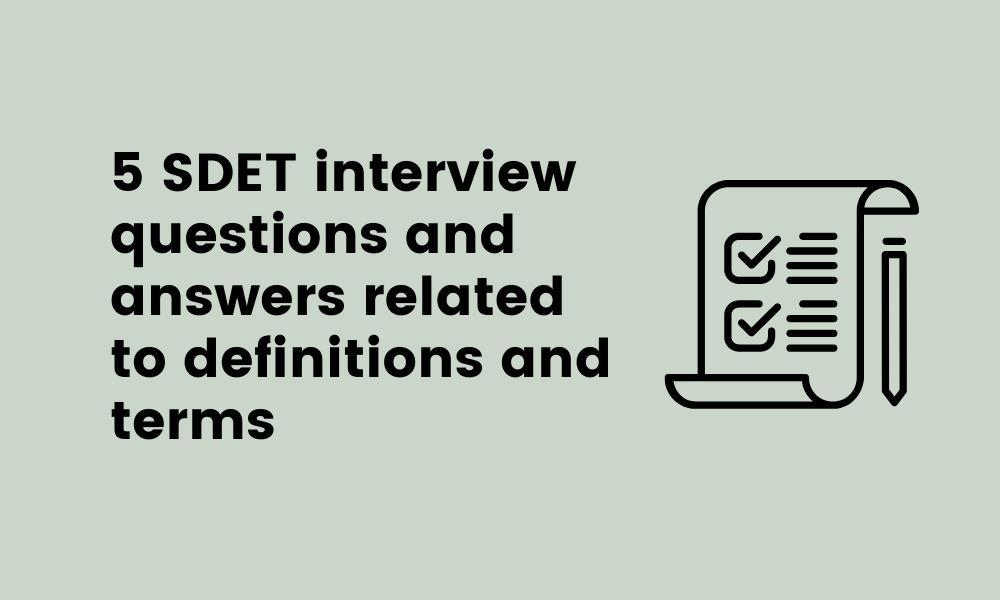39 SDET interview questions to hire top professionals
Hiring an SDET (Software Development Engineer in Test) professional is challenging due to the many hard and soft skills you must assess.
If you’re searching for the right SDET expert to hire for your organization, there are a couple of things you can do to ensure the process goes smoothly.
The first thing is to use a skills assessment featuring the right software tester skills tests in the hiring process – in the end of this article, you’ll find out more about skills testing and its benefits.
The second thing you should do is to use the right SDET interview questions when interviewing candidates.
Do you need a comprehensive list of SDET interview questions to assess your applicants? Use the 39 questions in this article to start making your list.
Table of contents
- 14 general SDET interview questions to ask applicants
- 5 general SDET interview questions and answers
- 5 SDET interview questions and answers related to definitions and terms
- 20 advanced SDET interview questions
- 5 advanced SDET interview questions and answers
- How skills testing can give your hiring process a boost
- 7 tips for hiring an the right SDET expert
- Hire an expert using the right SDET interview questions
14 general SDET interview questions to ask applicants
Evaluate your interviewees’ general knowledge by asking them these 14 general SDET interview questions.
Explain what SDET is.
Describe your experience with SDET.
Which skills do SDETs need?
Which soft skills do SDETs need?
How is an SDET different from manual testing?
Which method would you use to test text boxes?
Name some of the crucial principles of testing software.
Explain what exploratory testing is.
Explain what fuzz testing is.
Name the main test-case categories developers use.
Explain what ad-hoc testing is.
Explain what code inspection is.
What is an advantage of code inspection?
Name five main responsibilities of SDETs.
5 general SDET interview questions and answers
Find the answers to our selection of the five most critical general SDET interview questions below. Use them to evaluate your applicants’ responses.
1. Which skills do SDETs need?
Strong applicants will know that strong programming skills are just one skill required for SDETs. Two other important SDET skills are the ability to design tests and the right testing methodology knowledge.
2. Which soft skills do SDETs need?
Are your applicants aware that soft skills are also critical for SDETs? Can they name a few examples of soft skills that help them carry out their responsibilities? Crucial SDET soft skills include communication, time management, and organization skills.
3. Name the main test-case categories developers use.
Seasoned SDETs should have no problem naming the main test-case categories that developers use. Some examples are:
UI test cases
Database test cases
Security test cases
Performance test cases
Integration test cases
Usability test cases
Functionality test cases
4. Name some of the crucial principles of testing software.
If your applicants know the critical principles behind testing software, they may mention that defect clustering, early testing, and showing defects are vital.
Knowledgeable candidates may also explain that exhaustive testing isn’t possible, testing is context-dependent, and that the absence of error is a fallacy.
5. How is an SDET different from manual testers?
Applicants should know that SDETs are testers who also code and focus on design, testing, and implementation, whereas manual testers will test software tools after programmers develop them.
Your applicants may also explain that SDETs get involved in all stages of the software development lifecycle, where manual testers have fewer tasks and responsibilities and only focus on testing.
The best insights on HR and recruitment, delivered to your inbox.
Biweekly updates. No spam. Unsubscribe any time.
5 SDET interview questions and answers related to definitions and terms
Assess your interviewees’ knowledge by asking them these five SDET interview questions related to definitions and terms, and use the answers to evaluate their responses.
1. Explain what bug reports are in software testing and when you would use one.
Are your applicants aware that bug reports are comprehensive documents that highlight the bug-related problems with a website or software? Can they explain that bug reports let developers know how to fix these problems? Applicants may explain that SDETs use bug reports when they notice a part of the code isn’t functioning as expected. Then, they work towards tracking down the problem and create a bug report.
2. Explain the main elements of bug reports.
Some of the main elements of bug reports include the following:
A bug classification or title
A section for severity and priority of the problem
A description of the bug and when an SDET noticed it
A section for repro steps
Sections that detail the expected and actual results
A section for attachments that may feature screenshots or logs
3. Explain what severity is in software testing.
Skilled SDETs should know that severity refers to how much the fault can affect the software that they’re testing. High severity means that the flaw or bug significantly impacts the software’s functionality.
4. Explain what priority means in software testing.
Knowledgeable SDETs would know that priority relates to the order in which developers should fix bugs. If an SDET assigns a high priority to a bug, developers should fix it before others with a lower priority. If a bug has a low priority and only affects a small portion of the software, developers should fix it after others with a higher priority.
5. Explain the difference between severity and priority in software testing.
Applicants should know that priorities may be subjective values that can change as the project evolves, while severities remain the same. They may also explain that severities have more categories than priorities, and are affected by the product’s technical elements, whereas priorities are related to bug fixing schedules.
20 advanced SDET interview questions
Check whether your applicants have in-depth knowledge of testing procedures, tools, and best practices by asking them some of these advanced 20 SDET interview questions.
Which software testing tools do you know? Name five.
How is alpha testing different from beta testing?
Explain what performance testing is.
Explain what load testing is.
Explain the main differences between performance and load testing.
How do testers know whether developers can use a product in a live environment?
Explain what risk-based testing is.
Explain what equivalence partitioning is.
Name the critical stages of fuzz testing.
Name three bugs that developers can detect using fuzz testing.
Explain what quality assurance is.
Explain what quality control is.
Explain the difference between quality assurance and quality control.
Explain what a test script is.
Explain what a test case is.
Explain the difference between test scripts and a test case.
How is a walkthrough different from an inspection?
Explain what black-box testing is.
Explain what white-box testing is.
How is white-box testing different from black-box testing?
5 advanced SDET interview questions and answers
Assess your applicants’ knowledge and responses with the answers to five of the advanced SDET interview questions from the list above.
1. How do testers know whether developers can use a product in a live environment?
Experienced SDET candidates should know that products are only ready to use in a live environment when management tests are complete. Your applicants may explain that developers complete the following steps after management testing to ensure a bug-free product delivery:
Bug report validation, to check how developers resolved bugs
Completion, checks, and test case validation
Automated testing to prevent clashes between new and current features
Test coverage report validation to check that all test cases for component developments are complete
2. Explain the difference between quality assurance and quality control.
Can your applicants explain that quality assurance is a method that developers use to enhance the quality of projects? Are they aware that it involves planning and documenting quality standards at the beginning of the project?
Applicants should also know that quality control includes all work done to verify the output quality and whether it complies with quality standards.
3. How is white-box testing different from black-box testing?
Applicants should understand that black-box testing involves testing the software’s functioning instead of its coding or structure. A person who does this type of testing doesn’t need software development knowledge.
In contrast, white-box testing focuses on the internal workings of the software through the “clear box.” This process involves looking at the infrastructure of applications and performing unit and integration testing.
4. Explain the main differences between performance and load testing.
Your candidates should understand that performance testing determines whether a system is stable when it functions. The process involves understanding whether its speed, quality, and reliability work well under ordinary circumstances.
On the other hand, load testing involves determining whether a system performs well when various users simultaneously access the system. In load testing, testers use the maximum load to evaluate performance under great stress.
5. Which software testing tools do you know? Name five.
Applicants should be familiar with at least a few software testing tools. Some examples include:
TestMonitor
Practitest
Testpad
Spiratest
Xray
TestRail
How skills testing can give your hiring process a boost
When hiring an applicant, you may want to introduce a faster, more comprehensive candidate assessment process, which is something you can achieve with skills testing.
Skills testing is ideal for eliminating bias when hiring, comparing applicants’ skills quickly and efficiently, and reducing the time to hire.
With TestGorilla, you can choose up to five skills tests to include in a single assessment. Check out our test library to find out more about all the tests you can use to make candidate evaluation more efficient.
7 tips for hiring an the right SDET expert
Use these 7 tips during the recruitment process to hire a knowledgeable and skilled SDET expert.
1. Use skills testing to assess SDET technical skills
A pre-employment skills test is the fastest method to efficiently determine whether your candidates have what it takes to join your organization.
If you choose to integrate skills testing into your hiring process, always use this method immediately after receiving applications, and before (or even instead of) resume screening. This will allow you to quickly identify your most talented applicants, who you can then invite to an interview.
2. Introduce yourself and ask applicants to talk about their experience
The interview stage is a two-way street – the candidate wants to learn about your organization as much as you want to learn about them. Giving your applicants more information about your role in the organization is vital and will help them feel at ease.
You can then ask them to talk about their SDET experience. Taking this approach improves the candidate experience.
3. Start the interview with a few general SDET interview questions
Start slow. Begin the interview with a few general SDET interview questions to learn whether your applicant has the right general knowledge. You can then ask more complex SDET interview questions to get an idea of the depth of your applicants’ knowledge.
4. Use advanced SDET interview questions for senior roles
If you’re hiring for a junior role, use basic and general SDET interview questions only; if you’re hiring for a senior role, use advanced interview questions after that. In short, always match the difficulty of your interview questions to the role to guarantee a better candidate experience.
5. Note down your candidates’ responses
You can take notes during the interview. However, try not to be mindful of the process: Looking down at the page for long periods of time may seem as if you’re disinterested.
Instead, tell candidates that you will take notes when they respond and try to keep eye contact as much as possible while interviewing them.
6. Provide feedback to unsuccessful developers
To enhance the company’s reputation and the candidate experience, give meaningful feedback to candidates you didn’t choose. For instance, if a candidate’s technical SDET skills were not a good match, look at the skills assessment to determine the specific areas they need to work on.
7. Create tailored training sessions
After making the right hire, it’s time to focus on onboarding them. Look at their skills test results and the notes from the interview to get an idea of the areas in which your new employee might need extra help.
For example, if your new SDET developer lacks knowledge of certain software testing tools that you’re using, make it a priority to help them get familiar with them.
Hire an expert using the right SDET interview questions
Even though it’s not easy to hire an SDET expert, with skills testing and these SDET interview questions, you’ll be well prepared to assess applicants’ skills and knowledge.
Remember to use a skills assessment at the beginning of your recruitment process: This will help you make an objective selection of your best applicants to invite to an interview.
Hire SDET candidates quickly and efficiently. Use skills tests and the right SDET interview to hire the best talent for your team.
Get started with TestGorilla today and start making better hiring decisions, faster and bias-free.
You've scrolled this far
Why not try TestGorilla for free, and see what happens when you put skills first.


















